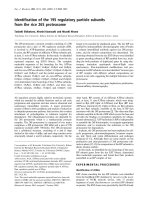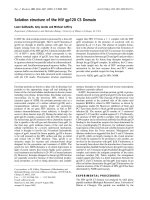Báo cáo y học: "Haemodynamic management of severe sepsis: recommendations of the French Intensive Care Societies (SFAR/SRLF) Consensus Conference, 13 October 2005, Paris, France" potx
Bạn đang xem bản rút gọn của tài liệu. Xem và tải ngay bản đầy đủ của tài liệu tại đây (382.52 KB, 4 trang )
Page 1 of 4
(page number not for citation purposes)
Available online />Abstract
We present a consensus report from the SFAR/SLRF (Société
Française d’Anesthésie et de Réanimation/Société de Réanimation
de Langue Française) Consensus Conference, held on 13 October
2005 in Paris, France. The consensus report made recommen-
dations on five topics relevant to the treatment of circulatory failure in
sepsis and its underlying rationale. These topics are as follows:
therapeutic goals of haemodynamic support in sepsis; goals of fluid
resuscitation (including transfusion); role of inotropes and vasoactive
drugs; role of other treatments; and treatment strategy. This report is
reproduced from a translation of the original in Annales Françaises
of Anesthésie and Réanimation.
Introduction
This consensus report is reproduced from a translation of the
original [1], which was published in French. It is limited to the
management of haemodynamic consequences of severe
sepsis. The treatment of associated organ failure (renal, hepatic
and haematological) is beyond the scope of this report.
The recommendations were made by the panel using
available scientific data and studies. The scientific value of
studies is divided into five levels as follows: level 1 includes
large randomized controlled trials with clear results, and low
risk for false positives (α error) or false negatives (β error);
level 2 includes smaller randomized controlled trials with less
clear results, and medium to high risk for false positives (α
error) or false negatives (β error); level 3 includes
nonrandomized studies with contemporaneous controls; level
4 includes nonrandomized studies with historical controls or
expert opinion; and level 5 includes case reports,
noncomparative studies, or expert opinion.
The strength of the recommendations is graded on the basis
of the level of evidence of the studies on which they are
based. Grade A recommendations are based on at least two
studies of level 1 evidence; grade B recommendations are
based on one level 1 study; grade C recommendations are
based on level 2 studies; grade D recommendations are
based on level 3 studies; and grade E recommendations are
based on level 4 or 5 studies. However, there may be
situations in which the level of scientific evidence available is
of insufficient quality to support the recommendation (i.e.
grade D or E) but the recommendation is considered
essential on clinical grounds.
Question 1: what are the therapeutic goals of
haemodynamic support in sepsis?
The different stages of sepsis are characterized by certain
circulatory changes. Circulatory changes exist at both
‘macrovascular’ and ‘microvascular’ (capillary) levels, but
presently there is no way to monitor microcirculatory
changes directly, and neither are any direct therapeutic
interventions available. Therefore, at present the therapeutic
goals are limited to the measurable macrocirculatory end-
points (arterial pressure, cardiac function and vascular
resistance of large vessels).
Hourly urine output, lactate levels and biochemical markers of
renal function are the only markers of microvascular perfusion
available (grade E). Correction of arterial hypotension
increases oxygen delivery to tissues and improves the
prognosis of patients with severe sepsis; therefore, early and
aggressive fluid loading is recommended (grade B). Apart from
Meeting report
Haemodynamic management of severe sepsis: recommendations
of the French Intensive Care Societies (SFAR/SRLF) Consensus
Conference, 13 October 2005, Paris, France
Thierry Pottecher
1
, Sylvie Calvat
2
, Hervé Dupont
3
, Jacques Durand-Gasselin
4
, Patrick Gerbeaux
5
and the SFAR/SRLF workgroup
1
Service d'anesthésie-réanimation, Hôpital de Hautepierre, F-67098 Strasbourg Cedex, France
2
Service de Réanimation Polyvalente, Centre Hospitalier d'Angoulême, F-16470 Saint Michel, France
3
Service de Réanimation Polyvalente, Hôpital Font-Pré, 1208 avenue du Colonel Picot, F-83000 Toulon, France
4
Unité de Réanimation Polyvalente, Département d'anesthésie-réanimation, Hôpital Nord, CHU d'Amiens 4, place Victor Pauchet, F-80054 Amiens
Cedex, France
5
Service des Urgences, Hôpital de la Conception, 145, boulevard Baille, F-13385 Marseille Cedex 5, France
Corresponding author: Thierry Pottecher,
Published: 10 July 2006 Critical Care 2006, 10:311 (doi:10.1186/cc4965)
This article is online at />© 2006 BioMed Central Ltd
MAP = mean arterial pressure; Scv
O
2
= vena cava oxygen saturation.
Page 2 of 4
(page number not for citation purposes)
Critical Care Vol 10 No 4 Pottecher et al.
the specific treatment of vasodilatation with vasoconstrictors,
there is no specific treatment for vascular dysfunction.
Except for coronary blood flow, all cardiac indices are
potentially modified by sepsis. However, only 10-20% of
adults with sepsis develop cardiac failure as characterized by
a persistently low cardiac index and mixed venous oxygen
saturation, despite adequate volume expansion. Treatment
with positive inotropes is indicated in these cases (grade B).
Specific differences in paediatric patients
Severe sepsis in children is more often characterized by
cardiac failure and hypovolaemia, which responds well to fluid
loading. However, the diagnosis is more difficult to establish
because hypotension develops later than in adults.
Prognosis is dependent on prompt diagnosis and intervention
with aggressive fluid therapy and early use of antibiotics
(grade D). The mortality rate in children is lower than in
adults, although fulminant purpuric sepsis warrants consider-
ation as a separate entity.
Question 2: What are the goals of fluid
resuscitation (including transfusion)?
Diagnosis and monitoring of volume deficit
The initial phase
Systematic intravenous fluid loading is the primary
management option in severe sepsis. There is no single
measurement required before commencing fluid resuscitation.
The recommended goal is to achieve and maintain a mean
arterial blood pressure (MAP) above 65 mmHg (grade C).
However, in cases of life-threatening hypotension (i.e. diastolic
blood pressure <40 mmHg), treatment with vasopressors must
be started immediately (grade E).
Ongoing fluid management
After the initial phase of fluid therapy, if intravenous filling is
still required then it must be done while monitoring and
aiming for specific haemodynamic targets (grade D).
Choice of fluids
Blood products, albumin, dextrans and starches with
molecular weights above 150 kDa should not be used as
first-line fluids for fluid resuscitation. When crystalloids and
colloids are titrated to the same haemodynamic target, they
have been shown to be equally efficacious. Crystalloids have
fewer potential side effects and are less expensive than
colloids; they are therefore recommended as first-choice
treatment for intravenous fluid resuscitation in managing the
initial phase of shock (grade B).
Volume and frequency of fluid boluses
Intravascular filling is achieved by 500 ml boluses of
crystalloids every 15 min (grade E). These boluses should be
repeated to achieve a MAP above 65 mmHg (without
developing signs of pulmonary oedema). If this target blood
pressure is not reached then the use of vasopressors is
indicated (grade E).
Blood transfusion
In the case of acute anaemia the target haemoglobin is
between 8 and 9 g/dl. There are situations in which different
haemoglobin levels may be acceptable, either in cases in
which it is not tolerated clinically or dependent on the vena
cava oxygen saturation (Svc
O
2
; grade E).
Specific differences in paediatric patients
During the first hour, intravascular fluid replacement up to a
volume of 60 ml/kg has been shown to reduce mortality and
is therefore recommended (grade E). For the reasons given
above for adults, crystalloids are the fluids of choice
(grade B).
Question 3: what is the role of inotropes and
vasoactive drugs?
Vasoconstictors
If despite adequate intravascular filling a MAP in excess of
65 mmHg cannot be achieved, then vasoconstrictors must be
used (grade B). Early use of vasoconstrictors is recom-
mended because it reduces the incidence of organ failure
(grade E). Noradrenaline (norepinephrine), a potent vaso-
constrictor, should be used in the first instance (grade E).
Vasopressin (0.01-0.04 units/min) or terlipressin (boluses of
1-2 mg) are rescue therapies in cases of refractory shock
(grade E).
Positive inotropes
Routine use of inotropes is not recommended (grade E). In
patients undergoing optimal management (adequate fluid
resuscitation, appropriate correction of anaemia and use of
vasoconstrictors), the indication for using inotropes cannot
be based on an isolated measurement of cardiac output. It is,
however, recommended when a low cardiac output is
accompanied by a Svc
O
2
below 70% (grade E). Inotrope
therapy must be titrated to a targeted response, such as
improvements in Svc
O
2
and in myocardial function indices,
and a reduction in lactate. The combination of dobutamine
and noradrenaline stimulates both α
1
and β
2
adrenergic
receptors, and it is recommended as first-line treatment
(grade E). Adrenaline appears equally efficacious but, because
of its metabolic side effects, it is not routinely used.
Specific differences in paediatric patients
Noradrenaline is recommended as the first-line vasoactive
drug treatment. Phosphodiesterase III inhibitors may also be
considered in cases of low cardiac output and normal arterial
pressure.
Question 4: what is the role of other
treatments?
The use of steroids is recommended in the treatment of
septic shock in patients who do not respond to a dose of
Page 3 of 4
(page number not for citation purposes)
250 µg of adrenocorticotrophic hormone (an appropriate
response is an increase in cortisol level by 9 µg/dl). The
recommended dose of hydrocortisone is 200-300 mg/day for
at least 5 days, followed by a tapering dose (grade E). There
is no role for activated protein C solely for the management of
haemodynamic parameters.
Haemofiltration is not recommended for the management of
haemodynamic shock (unless renal failure is present). There
is no place for other treatments aimed at removing inflam-
matory mediators, such as plasmopheresis (grade E).
An increased mortality rate has been described with the use
of one nitric oxide synthase inhibitor. Therefore, there is no
role for its use in the management of sepsis (grade B).
Specific differences in paediatric patients
The recommended dose of hydrocortisone is 1 mg/kg every
6 hours.
Question 5: what is the treatment strategy?
The speed at which treatment is started influences prognosis,
and so patients with septic shock must be managed promptly
Available online />Figure 1
Algorithm outlining the therapeutic strategy in sepsis. ACTH, adrenocorticotrophic hormone; MAP, mean arterial pressure; ScvO
2
, vena cava
oxygen saturation.
and using a standardized treatment algorithm (Figure 1).
Patients with life-threatening signs (decompensated blood
pressure, acute respiratory distress, or coma) must be
admitted directly to an intensive care unit.
Competing interests
The authors declare that they have no competing interests.
Acknowledgment
The organization committee members include C Martin (Président), T
Blanc, T Boulain, A Cariou, L Donetti, C Gervais, J Kienlen, O
Langeron, Y Malledant, G Orliaguet and C Paugam. The Scientific
Advisors were PE Bollaert and J Kienlen. The reference group included
E André, I Boyadjiev, O Gattolliat and S Gibot. Translation was done by
S Bailey.
Panel members included A de Lassence, R Gauzit, S Jaber, M Jour-
dain, E L’Her, C Lejus, F Plouvier and S Renolleau.
Reference
1. Pottecher T, Calvat S, Dupont H, Durand-Gasselin J, Gauzit R,
Gerbeaux P, Jaber S, Jourdain M, de Lassence A, Lejus C, L'her
E, Plouvier F, Renolleau S: Haemodynamic management of
severe sepsis (excluding neonates) [in French]. Conférence
de Consensus Commune (SFAR/SRLF). Elsevier: 2006; avail-
able online [www.sciencedirect.com]: Ann Fr Anesth Réanim
2006;25 or Réanimation 2006;15.
Critical Care Vol 10 No 4 Pottecher et al.
Page 4 of 4
(page number not for citation purposes)









